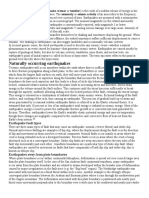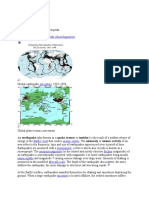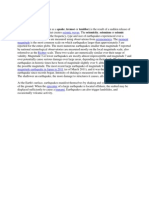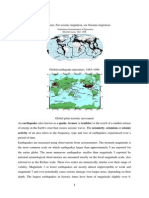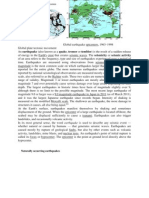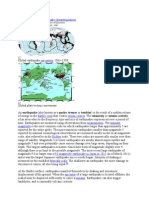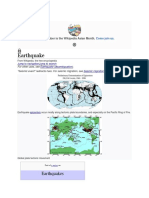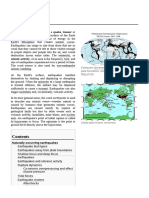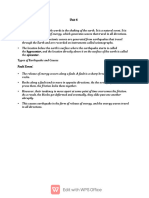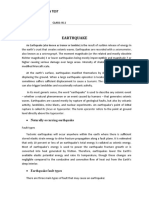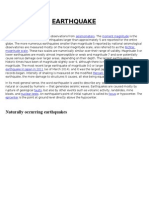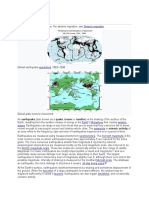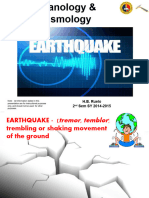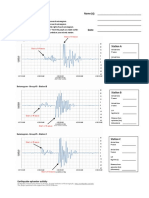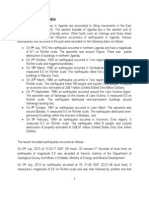Geo Pro 4 Elz
Geo Pro 4 Elz
Uploaded by
Gopika KailasCopyright:
Available Formats
Geo Pro 4 Elz
Geo Pro 4 Elz
Uploaded by
Gopika KailasOriginal Title
Copyright
Available Formats
Share this document
Did you find this document useful?
Is this content inappropriate?
Copyright:
Available Formats
Geo Pro 4 Elz
Geo Pro 4 Elz
Uploaded by
Gopika KailasCopyright:
Available Formats
An earthquake (also known as a quake, tremor or temblor) is the result of a sudden release of energy in the Earth's crust that
creates seismic waves. The seismicity, seismism or seismic activity of an area refers to the frequency, type and size of earthquakes experienced over a period of time. Earthquakes are measured using observations from seismometers. The moment magnitude is the most common scale on which earthquakes larger than approximately 5 are reported for the entire globe. The more numerous earthquakes smaller than magnitude 5 reported by national seismological observatories are measured mostly on the local magnitude scale, also referred to as the Richter scale. These two scales are numerically similar over their range of validity. Magnitude 3 or lower earthquakes are mostly almost imperceptible and magnitude 7 and over potentially cause serious damage over large areas, depending on their depth. The largest earthquakes in historic times have been of magnitude slightly over 9, although there is no limit to the possible magnitude. The most recent large earthquake of magnitude 9.0 or larger was a9.0 magnitude earthquake in Japan in 2011 (as of March 2011), and it was the largest Japanese earthquake since records began. Intensity of shaking is measured on the modified Mercalli scale. The shallower an earthquake, the more damage to structures it causes, all else being equal. At the Earth's surface, earthquakes manifest themselves by shaking and sometimes displacement of the ground. When the epicentre of a large earthquake is located offshore, the seabed may be displaced sufficiently to cause a tsunami. Earthquakes can also trigger landslides, and occasionally volcanic activity.
In its most general sense, the word earthquake is used to describe any seismic event whether natural or caused by humans that generates seismic waves. Earthquakes are caused mostly by rupture of geological faults, but also by other events such as volcanic activity, landslides, mine blasts, and nuclear tests. An earthquake's point of initial rupture is called its focus or hypocenter. The epicentre is the point at ground level directly above the hypocenter.
Tectonic earthquakes occur anywhere in the earth where there is sufficient stored elastic strain energy to drive fracture propagation along a fault plane. The sides of a fault move past each other smoothly and a seismically only if there are no irregularities or asperities along the fault surface that increase the frictional resistance. Most fault surfaces do have such asperities and this leads to a form of stick-slip behaviour. Once the fault has locked, continued relative motion between the plates leads to increasing stress and therefore, stored strain energy in the volume around the fault surface. This continues until the stress has risen sufficiently to break through the asperity, suddenly allowing sliding over the locked portion of the fault, releasing the stored energy. This energy is released as a combination of radiated elastic strain seismic waves, frictional heating of the fault surface, and cracking of the rock, thus causing an earthquake. This process of gradual build-up of strain and stress punctuated by occasional sudden earthquake failure is referred to as the elastic-rebound theory. It is estimated that only 10 percent or less of an earthquake's total energy is radiated as seismic energy. Most of the earthquake's energy is used to power the earthquake fracture growth or is converted into heat generated by friction. Therefore, earthquakes lower the Earth's available elastic potential energy and raise its temperature, though these changes are negligible compared to the conductive and convective flow of heat out from the Earth's deep interior..
Earthquakes and volcanic activity
Earthquakes often occur in volcanic regions and are caused there, both by tectonic faults and the movement of magma in volcanoes. Such earthquakes can serve as an early warning of volcanic eruptions, as during the Mount St. Helens eruption of 1980. Earthquake swarms can serve as markers for the location of the flowing magma throughout the volcanoes. These swarms can be recorded by seismometers and tilt meters (a device that measures ground slope) and used as sensors to predict imminent or upcoming eruptions.[17]
Rupture dynamics
A tectonic earthquake begins by an initial rupture at a point on the fault surface, a process known as nucleation. The scale of the nucleation zone is uncertain, with some evidence, such as the rupture dimensions of the smallest earthquakes, suggesting that it is smaller than 100 m while other evidence, such as a slow component revealed by low-frequency spectra of some earthquakes, suggest that it is larger. The possibility that the nucleation involves some sort of preparation process is supported by the observation that about 40% of earthquakes are
preceded by foreshocks. Once the rupture has initiated it begins to propagate along the fault surface. The mechanics of this process are poorly understood, partly because it is difficult to recreate the high sliding velocities in a laboratory. Also the effects of strong ground motion make it very difficult to record information close to a nucleation zone.[18] Rupture propagation is generally modeled using a fracture mechanics approach, likening the rupture to a propagating mixed mode shear crack. The rupture velocity is a function of the fracture energy in the volume around the crack tip, increasing with decreasing fracture energy. The velocity of rupture propagation is orders of magnitude faster than the displacement velocity across the fault. Earthquake ruptures typically propagate at velocities that are in the range 7090 % of the S-wave velocity and this is independent of earthquake size. A small subset of earthquake ruptures appear to have propagated at speeds greater than the S-wave velocity. These supershear earthquakes have all been observed during large strike-slip events. The unusually wide zone of coseismic damage caused by the 2001 Kunlun earthquake has been attributed to the effects of the sonic boom developed in such earthquakes. Some earthquake ruptures travel at unusually low velocities and are referred to as slow earthquakes. A particularly dangerous form of slow earthquake is the tsunami earthquake, observed where the relatively low felt intensities, caused by the slow propagation speed of some great earthquakes, fail to alert the population of the neighbouring coast, as in the 1896 Meiji-Sanriku earthquake.[18]
Tidal forces
See also: Earthquake prediction#Earth tides as triggers Research work has shown a robust correlation between small tidally induced forces and non-volcanic tremor activity.[19][20][21][22]
Earthquake clusters
Most earthquakes form part of a sequence, related to each other in terms of location and time.[23] Most earthquake clusters consist of small tremors that cause little to no damage, but there is a theory that earthquakes can recur in a regular pattern.[24]
Aftershocks
Main article: Aftershock An aftershock is an earthquake that occurs after a previous earthquake, the mainshock. An aftershock is in the same region of the main shock but always of a smaller magnitude. If an aftershock is larger than the main shock, the aftershock is redesignated as the main shock and the original main shock is redesignated as a foreshock. Aftershocks are formed as the crust around the displaced fault plane adjusts to the effects of the main shock.[23]
Earthquake swarms
Main article: Earthquake swarm Earthquake swarms are sequences of earthquakes striking in a specific area within a short period of time. They are different from earthquakes followed by a series of aftershocks by the fact that no single earthquake in the sequence is obviously the main shock, therefore none have notable higher magnitudes than the other. An example of an earthquake swarm is the 2004 activity at Yellowstone National Park.[25]
Earthquake storms
Main article: Earthquake storm Sometimes a series of earthquakes occur in a sort of earthquake storm, where the earthquakes strike a fault in clusters, each triggered by the shaking or stress redistribution of the previous earthquakes. Similar to aftershocks but on adjacent segments of fault, these storms occur over the course of years, and with some of the later earthquakes as damaging as the early ones. Such a pattern was observed in the sequence of about a dozen earthquakes that struck the North Anatolian Fault in Turkey in the 20th century and has been inferred for older anomalous clusters of large earthquakes in the Middle East.[26][27]
Measuring and locating earthquakes
Main article: Seismology
Earthquakes can be recorded by seismometers up to great distances, because seismic waves travel through the whole Earth's interior. The absolute magnitude of a quake is conventionally reported by numbers on the Moment magnitude scale (formerly Richter scale, magnitude 7 causing serious damage over large areas), whereas the felt magnitude is reported using the modified Mercalli intensity scale (intensity IIXII). Every tremor produces different types of seismic waves, which travel through rock with different velocities: Longitudinal P-waves (shock- or pressure waves) Transverse S-waves (both body waves) Surface waves (Rayleigh and Love waves)
Propagation velocity of the seismic waves ranges from approx. 3 km/s up to 13 km/s, depending on the density and elasticity of the medium. In the Earth's interior the shock- or P waves travel much faster than the S waves (approx. relation 1.7 : 1). The differences in travel time from the epicentre to the observatory are a measure of the distance and can be used to image both sources of quakes and structures within the Earth. Also the depth of the hypocenter can be computed roughly. In solid rock P-waves travel at about 6 to 7 km per second; the velocity increases within the deep mantle to ~13 km/s. The velocity of S-waves ranges from 23 km/s in light sediments and 45 km/s in the Earth's crust up to 7 km/s in the deep mantle. As a consequence, the first waves of a distant earth quake arrive at an observatory via the Earth's mantle. Rule of thumb: On the average, the kilometer distance to the earthquake is the number of seconds between the P and S wave times 8.[43] Slight deviations are caused by inhomogeneities of subsurface structure. By such analyses of seismograms the Earth's core was located in 1913 by Beno Gutenberg. Earthquakes are not only categorized by their magnitude but also by the place where they occur. The world is divided into 754 Flinn-Engdahl regions (F-E regions), which are based on political and geographical boundaries as well as seismic activity. More active zones are divided into smaller F-E regions whereas less active zones belong to larger F-E regions.
Effects of earthquakes
The effects of earthquakes include, but are not limited to, the following:
Shaking and ground rupture
Shaking and ground rupture are the main effects created by earthquakes, principally resulting in more or less severe damage to buildings and other rigid structures. The severity of the local effects depends on the complex combination of the earthquake magnitude, the distance from theepicenter, and the local geological and geomorphological conditions, which may amplify or reduce wave propagation.[44] The ground-shaking is measured by ground acceleration. Specific local geological, geomorphological, and geostructural features can induce high levels of shaking on the ground surface even from low-intensity earthquakes. This effect is called site or local amplification. It is principally due to the transfer of the seismic motion from hard deep soils to soft superficial soils and to effects of seismic energy focalization owing to typical geometrical setting of the deposits. Ground rupture is a visible breaking and displacement of the Earth's surface along the trace of the fault, which may be of the order of several metres in the case of major earthquakes. Ground rupture is a major risk for large engineering structures such as dams, bridges and nuclear power stations and requires careful mapping of existing faults to identify any which are likely to break the ground surface within the life of the structure.[45]
Landslides and avalanches
Main article: Landslide Earthquakes, along with severe storms, volcanic activity, coastal wave attack, and wildfires, can produce slope instability leading to landslides, a major geological hazard. Landslide danger may persist while emergency personnel are attempting rescue.[46]
Fires
Fires of the 1906 San Francisco earthquake
Earthquakes can cause fires by damaging electrical power or gas lines. In the event of water mains rupturing and a loss of pressure, it may also become difficult to stop the spread of a fire once it has started. For example, more deaths in the 1906 San Francisco earthquake were caused by fire than by the earthquake itself.[47]
Soil liquefaction
Main article: Soil liquefaction Soil liquefaction occurs when, because of the shaking, water-saturated granular material (such as sand) temporarily loses its strength and transforms from a solid to a liquid. Soil liquefaction may cause rigid structures, like buildings and bridges, to tilt or sink into the liquefied deposits. This can be a devastating effect of earthquakes. For example, in the 1964 Alaska earthquake, soil liquefaction caused many buildings to sink into the ground, eventually collapsing upon themselves.[48]
Tsunami
Main article: Tsunami
The tsunami of the 2004 Indian Ocean earthquake
Tsunamis are long-wavelength, long-period sea waves produced by the sudden or abrupt movement of large volumes of water. In the open ocean the distance between wave crests can surpass 100 kilometers (62 mi), and the wave periods can vary from five minutes to one hour. Such tsunamis travel 600-800 kilometers per hour (373 497 miles per hour), depending on water depth. Large waves produced by an earthquake or a submarine landslide can overrun nearby coastal areas in a matter of minutes. Tsunamis can also travel thousands of kilometers across open ocean and wreak destruction on far shores hours after the earthquake that generated them.[49] Ordinarily, subduction earthquakes under magnitude 7.5 on the Richter scale do not cause tsunamis, although some instances of this have been recorded. Most destructive tsunamis are caused by earthquakes of magnitude 7.5 or more.[49]
Floods
Main article: Flood
A flood is an overflow of any amount of water that reaches land.[50] Floods occur usually when the volume of water within a body of water, such as a river or lake, exceeds the total capacity of the formation, and as a result some of the water flows or sits outside of the normal perimeter of the body. However, floods may be secondary effects of earthquakes, if dams are damaged. Earthquakes may cause landslips to dam rivers, which collapse and cause floods.[51] The terrain below the Sarez Lake in Tajikistan is in danger of catastrophic flood if the landslide dam formed by the earthquake, known as the Usoi Dam, were to fail during a future earthquake. Impact projections suggest the flood could affect roughly 5 million people.[52]
Human impacts
A large ferry boat rests inland amidst destroyed houses after a 9.0 earthquakeand subsequent tsunami struck Japan in March 2011.
An earthquake may cause injury and loss of life, road and bridge damage, general property damage (which may or may not be covered byearthquake insurance), and collapse or destabilization (potentially leading to future collapse) of buildings. The aftermath may bring disease, lack of basic necessities, and higher insurance premiums
. Mullaperiyar Dam or Mullai Periyar Dam is amasonry gravity dam on the Periyar River in the Kerala state of India.[1][2][5] It is located 881 m (2,890 ft) above mean sea level on theCardamom Hills of the Western Ghats in Thekkady, Idukki District of Kerala, South India. It was constructed between 1887 and 1895 by the British Government to divert water eastwards to Madras Presidency area (the present-day Tamil Nadu). It has a height of 53.6 m (176 ft) from the foundation and length of 365.7 m (1,200 ft).[1] The Periyar National Park in Thekkady is located around the dam's reservoir. The dam and the river are owned by and located in Kerala [1] but the dam is controlled and operated under a period lease by neighboring Tamil Nadu state.[1] The control and safety of the dam and the validity and fairness of the lease agreement have been points of dispute between Kerala and Tamil Nadu states.[6] The dam is an 'endangered' scheduled dam under the Kerala Irrigation and Water Conservation (Amendment) Act, 2006.[7]
You might also like
- CIE5260 Slides 2019Document962 pagesCIE5260 Slides 2019language.ameyNo ratings yet
- Naturally Occurring Earthquakes: Earthquake Fault TypesDocument6 pagesNaturally Occurring Earthquakes: Earthquake Fault TypesJoel JollyNo ratings yet
- Earthquake: Naturally Occurring EarthquakesDocument13 pagesEarthquake: Naturally Occurring EarthquakesYogesh ShirodkarNo ratings yet
- Earthquake: Navigation SearchDocument14 pagesEarthquake: Navigation SearchSyuk-run Mohd NoorNo ratings yet
- Earthquake: From Wikipedia, The Free EncyclopediaDocument11 pagesEarthquake: From Wikipedia, The Free EncyclopediaSoulcoldNo ratings yet
- EathquakeDocument8 pagesEathquakeCrazy CarNo ratings yet
- Earthquake: From Wikipedia, The Free EncyclopediaDocument13 pagesEarthquake: From Wikipedia, The Free EncyclopediaAjay NautiyalNo ratings yet
- Causes of Earthquakes: The Surface of The Earth Is Divided Into Pieces Called "Tectonic Plates"Document5 pagesCauses of Earthquakes: The Surface of The Earth Is Divided Into Pieces Called "Tectonic Plates"rranbir07No ratings yet
- Earthquake: Naturally Occurring EarthquakesDocument1 pageEarthquake: Naturally Occurring EarthquakesBelteshazzarL.CabacangNo ratings yet
- Earthquake: Naturally Occurring EarthquakesDocument5 pagesEarthquake: Naturally Occurring EarthquakesShree VidhyaNo ratings yet
- Earthquake: EarthquakesDocument12 pagesEarthquake: EarthquakesEmmanuelFrancoNo ratings yet
- Earthquake - Wikipedia, The Free EncyclopediaDocument16 pagesEarthquake - Wikipedia, The Free EncyclopediaRam BabuNo ratings yet
- Earthquake: "Seismic Event" Redirects Here. For Seismic Migration, SeeDocument21 pagesEarthquake: "Seismic Event" Redirects Here. For Seismic Migration, SeeGayathri Manjunath ShepurNo ratings yet
- Types of EarthquakesDocument6 pagesTypes of EarthquakesMarvin EstebanNo ratings yet
- Nama: I Gusti Ngurah Oka Wirajaya Kelas: XI IPA 8 No: 15Document26 pagesNama: I Gusti Ngurah Oka Wirajaya Kelas: XI IPA 8 No: 15Bolivar Nova PinedaNo ratings yet
- Geography IndiaDocument173 pagesGeography IndiaArvind KumarNo ratings yet
- Earthquake: Earth's Crust Seismic Waves Seismometers Moment MagnitudeDocument27 pagesEarthquake: Earth's Crust Seismic Waves Seismometers Moment Magnitudesaurabh_565No ratings yet
- Naturally Occurring Earthquakes: Earth's Crust Seismic WavesDocument9 pagesNaturally Occurring Earthquakes: Earth's Crust Seismic WavesAksh BatraNo ratings yet
- Earth's Crust Seismic WavesDocument6 pagesEarth's Crust Seismic WavesRemya R. KumarNo ratings yet
- EarthquakeDocument40 pagesEarthquakePrabhat Sharma0% (1)
- Earthquake: Navigation SearchDocument16 pagesEarthquake: Navigation SearchSaad Usman RaoNo ratings yet
- Earthquake - WikipediaDocument99 pagesEarthquake - Wikipediachiranth2911No ratings yet
- Earthquak 1Document3 pagesEarthquak 1Śáńtőśh MőkáśhíNo ratings yet
- Naturally Occurring EarthquakesDocument4 pagesNaturally Occurring EarthquakesbhupenderkNo ratings yet
- Earthquake IntroductionDocument4 pagesEarthquake IntroductionHimanshuNo ratings yet
- GempabumiDocument21 pagesGempabumihendro ajahNo ratings yet
- EARTHQUAKEDocument13 pagesEARTHQUAKEmonijose2001No ratings yet
- TsunamiDocument15 pagesTsunamiRajeshwari RajeNo ratings yet
- Earth Quakes and Dams-3Document16 pagesEarth Quakes and Dams-3Vitalis KinyuaNo ratings yet
- EarthquakeDocument25 pagesEarthquakewuehiufwNo ratings yet
- EarthquakeDocument2 pagesEarthquakeSumit JdNo ratings yet
- Earth's Crust Seismic Waves: EarthquakeDocument7 pagesEarth's Crust Seismic Waves: Earthquakeronhuman14No ratings yet
- Introduction To EarthquakeDocument7 pagesIntroduction To EarthquakeJane EspañolaNo ratings yet
- EarthquakeDocument3 pagesEarthquakeemNo ratings yet
- Chapter One Introduction To Earthquakes and Earthquakes EngineeringDocument8 pagesChapter One Introduction To Earthquakes and Earthquakes EngineeringAhmed Abd-AlmoujoodNo ratings yet
- Causes of EarthquakesDocument8 pagesCauses of Earthquakesdumea paulNo ratings yet
- Unit 1 Nature of DisastersDocument30 pagesUnit 1 Nature of DisastersacornaNo ratings yet
- EarthquakesDocument9 pagesEarthquakesAnkitNo ratings yet
- UntitledDocument6 pagesUntitledMarc LorenzNo ratings yet
- What Is An EarthquakeDocument2 pagesWhat Is An Earthquakeidowu folukeNo ratings yet
- EarthquakeDocument21 pagesEarthquakejona80563No ratings yet
- Unit 4 DMDocument14 pagesUnit 4 DMAman SinghNo ratings yet
- EarthquakeDocument6 pagesEarthquakeJohnrey DapitoNo ratings yet
- Earthquake: English Final Spoken TestDocument2 pagesEarthquake: English Final Spoken TestardanesiamahrafNo ratings yet
- Earthquake: Causes of EarthquakesDocument9 pagesEarthquake: Causes of EarthquakesChetan KaushikNo ratings yet
- Glossary in Seismology: Active FaultDocument9 pagesGlossary in Seismology: Active FaultBobby WskNo ratings yet
- Engineering Geography: EarthquakeDocument23 pagesEngineering Geography: EarthquakeDaljeet SidhuNo ratings yet
- Earthquake: Naturally Occurring EarthquakesDocument13 pagesEarthquake: Naturally Occurring EarthquakesnavinkapilNo ratings yet
- Disaster 12 - W7Document11 pagesDisaster 12 - W7Rosalie Navales LegaspiNo ratings yet
- Earthquke PresentationDocument34 pagesEarthquke PresentationKenny CantilaNo ratings yet
- Definition of EarthquakeDocument12 pagesDefinition of Earthquakeroyani1965No ratings yet
- National Earthquake Information Center Glossary TermsDocument4 pagesNational Earthquake Information Center Glossary TermsTimberlyNo ratings yet
- Earthquake: "Seismic Event" Redirects Here. For Seismic Migration, SeeDocument2 pagesEarthquake: "Seismic Event" Redirects Here. For Seismic Migration, SeeNitish JalanNo ratings yet
- Contoh Explanation Text About EarthquakeDocument2 pagesContoh Explanation Text About EarthquakePutra Ongoes100% (1)
- Engg Seismolog A MasoodDocument28 pagesEngg Seismolog A MasoodShah Nawaz KhanNo ratings yet
- DisastersDocument8 pagesDisastersjaninepenelope07No ratings yet
- Earthquake Booklet PDFDocument16 pagesEarthquake Booklet PDFdehgruybfghyNo ratings yet
- Earthquake Booklet PDFDocument16 pagesEarthquake Booklet PDFdehgruybfghyNo ratings yet
- The Ground Is Shaking! What Happens During An Earthquake? Geology for Beginners| Children's Geology BooksFrom EverandThe Ground Is Shaking! What Happens During An Earthquake? Geology for Beginners| Children's Geology BooksNo ratings yet
- Waves of Destruction: The Science behind Tsunami Formation and Its Impact on LifeFrom EverandWaves of Destruction: The Science behind Tsunami Formation and Its Impact on LifeNo ratings yet
- 01.atenuaciones de Las Intensidades Sismicas en La Cordillera de Los Andes Centrales, BoliviaDocument10 pages01.atenuaciones de Las Intensidades Sismicas en La Cordillera de Los Andes Centrales, BoliviaIva Valencia HuaxoNo ratings yet
- Faultline QuestionaireDocument3 pagesFaultline QuestionaireDonna Sheena SaberdoNo ratings yet
- EARTHQUAKESDocument2 pagesEARTHQUAKESGuy SistersNo ratings yet
- Design Code For IndonesiaDocument3 pagesDesign Code For IndonesiaAmol GoleNo ratings yet
- Dr. Fawad A. Najam - Are We Prepared Enough For The Next Big One PDFDocument65 pagesDr. Fawad A. Najam - Are We Prepared Enough For The Next Big One PDFMuhammad UsmanNo ratings yet
- Case StudyDocument11 pagesCase StudyAbad Rhea BitongNo ratings yet
- EarthquakesDocument28 pagesEarthquakesHernulfo RueloNo ratings yet
- Earthquake HazardsDocument70 pagesEarthquake HazardsVismin Derecho LawasNo ratings yet
- pp1707 PDFDocument146 pagespp1707 PDFAlex RobertshawNo ratings yet
- ENGL120 Reading 3-1 - Three Stories About Natural DisastersDocument3 pagesENGL120 Reading 3-1 - Three Stories About Natural DisastersLuccas BachNo ratings yet
- Earthquake 101Document1 pageEarthquake 101Steven LiwagNo ratings yet
- UBC97 Earthquak Lateral Forces-Edit Protected - 09!06!2012Document19 pagesUBC97 Earthquak Lateral Forces-Edit Protected - 09!06!2012Yasser AbdAllah SnosyNo ratings yet
- Risk To EarthquakesDocument6 pagesRisk To EarthquakesCrizel VeraNo ratings yet
- Earthquake: Epicenter and FocusDocument30 pagesEarthquake: Epicenter and FocusAlven ReyNo ratings yet
- Lab Epicenter Seismogram5Document1 pageLab Epicenter Seismogram5Jose PalaciosNo ratings yet
- 13 - (Seismic) Lateral Loads Effects (Eng. A. Farghal)Document114 pages13 - (Seismic) Lateral Loads Effects (Eng. A. Farghal)Anonymous 0tT3SeNo ratings yet
- Cubrinovski Et Al. 2018 - System Response of Lique Able DepositsDocument18 pagesCubrinovski Et Al. 2018 - System Response of Lique Able DepositsLale ÖnerNo ratings yet
- Graphic Organizer: Beginning/ExpositionDocument2 pagesGraphic Organizer: Beginning/ExpositionHelloNo ratings yet
- Plate Tectonics Power PointDocument25 pagesPlate Tectonics Power PointLory Grace TorresNo ratings yet
- Q1-Week 1 - Find It's CenterDocument4 pagesQ1-Week 1 - Find It's CenterFrenzy Mei JobleNo ratings yet
- Explanation TextDocument2 pagesExplanation Textclark lelouchNo ratings yet
- Earthquakes in Uganda 2Document4 pagesEarthquakes in Uganda 2The New VisionNo ratings yet
- ECP201-2008 Earthquake Lateral Forces - Protected-09!06!2012Document23 pagesECP201-2008 Earthquake Lateral Forces - Protected-09!06!2012magdyamdbNo ratings yet
- Earthquake Damage Report With PicturesDocument3 pagesEarthquake Damage Report With PicturesGeovanni Collantes DumpasanNo ratings yet
- 2023 Turkey EarthquakeDocument18 pages2023 Turkey EarthquakeAya KhalifaNo ratings yet
- Infographic Tsunami - Jessica MPH 5 PDFDocument1 pageInfographic Tsunami - Jessica MPH 5 PDFJessicaNo ratings yet
- BS Braced FrameDocument7 pagesBS Braced FrameUcok DedyNo ratings yet
- CSS General Science & Ability NotesDocument6 pagesCSS General Science & Ability NotesEman KhurramNo ratings yet
- The Balochistan Earthquake 2013Document14 pagesThe Balochistan Earthquake 2013Zain Nabi KhanNo ratings yet

